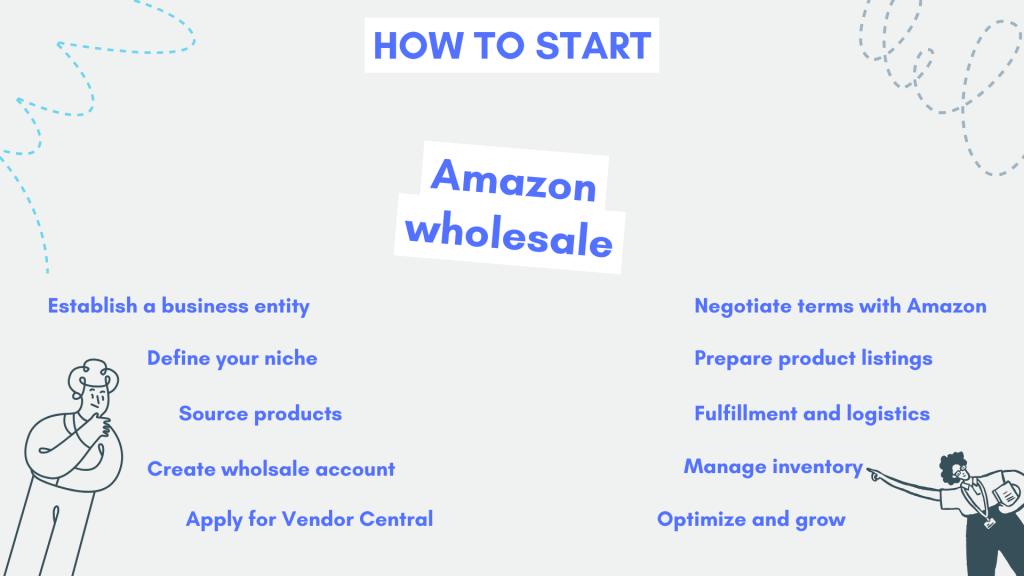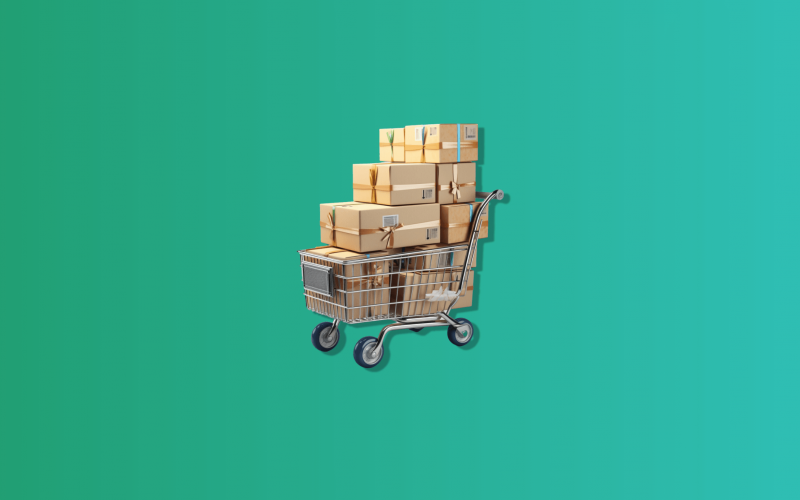Amazon wholesale has emerged as a strategic avenue for entrepreneurs and businesses seeking to thrive in the digital marketplace. This article explores wholesale on Amazon. We’ll look at the dynamics of wholesale on Amazon, its significance, the underlying business model, and how businesses can leverage this platform for success.
Quick history of Amazon
The roots of Amazon trace back to a humble garage in Seattle, where Jeff Bezos set out to create an online bookstore. Since its inception in 1994, the company quickly diversified its offerings beyond literature, expanding into electronics, apparel, and more. The introduction of Amazon Marketplace in 2000 marked a paradigm shift, allowing third-party sellers to join the ecosystem and offer their products alongside Amazon inventory.
General overview of Amazon
Amazon Marketplace is a vast online retail platform that connects buyers and sellers globally. The platform operates on a dual model: Amazon Retail, where the company sells its own products, and Amazon Marketplace, which facilitates transactions between an independent seller and customers. With millions of active users, the Marketplace spans numerous product categories, from electronics to handmade crafts.
Benefits of running a business on Amazon Marketplace
Amazon offers many benefits to a seller (not just in wholesale). Let’s look at the major pros of selling products on Amazon.
- Global reach
Extensive customer base Amazon offers provides unparalleled exposure for businesses, allowing them to reach millions of potential customers worldwide. - Infrastructure and logistics
Leveraging Amazon robust infrastructure, businesses can benefit from reliable order fulfillment, streamlined shipping processes, and access to the renowned logistics network of Amazon. - Trust and credibility
The Amazon brand carries a reputation for reliability and customer satisfaction. Businesses operating on the platform can leverage this trust to establish credibility with consumers. - Marketing and advertising
Amazon offers a suite of marketing and advertising tools to help businesses promote their products effectively. From sponsored product listings to targeted ad campaigns, a seller can enhance their visibility and attract a larger audience. - Customer service
The commitment of to customer satisfaction extends to its third-party sellers. The platform provides customer service support, allowing businesses to focus on product development and growth.
Understanding selling wholesale
Amazon Marketplace provides a versatile platform for a seller wishing to tailor their business models according to their preferences and goals. Wholesale is one of these models (apart from wholesale there are also retail and dropshipping, etc.). And before looking at how it works on Amazon, let’s recap the meaning of wholesale real quick.
Related: If you’re interested in the dropshipping business model, you might want to read about how Amazon dropshipping works.
What’s wholesale business?
Wholesale means that you buy goods or products in large quantities from manufacturers or distributors at discounted rates and then sell these items in smaller numbers to retailers or other businesses.
The wholesale model is characterized by bulk transactions, typically involving substantial quantities of goods, and serves as an intermediary step in the supply chain, facilitating the efficient distribution of wholesale products from producers to retailers.
This approach allows every seller to benefit from economies of scale, offering reduced per-unit costs and giving retailers access to diverse products without direct engagement with manufacturers. Let’s have some more details about it.
- Fundamental dynamics
The wholesale business model involves a symbiotic partnership between product manufacturers (or authorized distributors) and retailers. Manufacturers produce products in bulk, and wholesalers buy these products at discounted rates. The latter, in turn, distribute the products to retailers, who ultimately sell them to consumers. - Strategic collaboration and scaling
Wholesale transactions are characterized by strategic collaboration, enabling manufacturers to produce goods at scale and distributors to benefit from bulk product pricing. Wholesale suppliers act as intermediaries, streamlining the distribution process and providing retailers with access to a wide range of products without the complexities of direct engagement with manufacturers. - Distribution channels
Wholesale suppliers play a significant role in the supply chain, acting as intermediaries between manufacturers and retailers. They buy large amounts of products, warehouse them, and then distribute smaller quantities to retailers. This process enhances efficiency and reduces logistical complexities for both manufacturers and retailers. - Benefits for manufacturers and wholesaler
Manufacturers benefit from the wholesale model by achieving economies of scale, producing goods in larger quantities, and reducing per-unit production costs. Wholesale suppliers, on the other hand, capitalize on the ability to buy products in bulk at discounted rates, facilitating a more streamlined and cost-effective distribution process. - Challenges and considerations
While the wholesale model provides numerous benefits, challenges include navigating negotiations on pricing and terms, managing inventory effectively, and adapting to market fluctuations. Successful implementation requires a delicate balance between offering competitive pricing to retailers and maintaining sustainable profit.
How does wholesale on Amazon work
The wholesale business model on Amazon involves a strategic collaboration between manufacturers, distributors, and the ecommerce platform. Here’s a breakdown of how the wholesale business model works on Amazon:
- Manufacturer or distributor engagement
Manufacturers or authorized distributors produce goods in large quantities. These manufacturers or distributors engage with Amazon as wholesale sellers, offering their products to the platform in bulk. - Amazon vendor central: the nexus for wholesale
Amazon Vendor Central serves as the central hub for wholesale transactions. Manufacturers or distributors, known as vendors, establish a direct relationship with Amazon through Vendor Central. Vendors receive purchase orders from Amazon and ship products in bulk to Amazon fulfillment centers. - Inventory management and order fulfillment
Amazon takes on the responsibility of managing the inventory stored in its fulfillment centers. When a customer places an order, Amazon handles the order fulfillment process, including picking, packing, and shipping the products directly to the end consumer. - Negotiation of terms and pricing
Vendors negotiate terms and pricing with Amazon, determining the discounted rates at which they sell their products in bulk to the platform. These negotiations often involve considerations such as payment terms, shipping terms, and the overall structure of the wholesale agreement. - Access to customer base
By engaging in wholesale with Amazon, vendors gain access to the vast customer base of the e-commerce giant. Products listed on Amazon through the wholesale model benefit from the platform’s established infrastructure, marketing reach, and customer trust.
So, Amazon wholesale business model facilitates a symbiotic relationship between manufacturers, distributors, and the platform, streamlining the distribution process and providing access to a broad customer base for a seller engaging in bulk transactions.
A quick look at Wholesale FBA
Though having a lot in common, there is a difference between Amazon Wholesale and Amazon Wholesale FBA. Let’s break down each concept.
Amazon Wholesale
- In the Wholesale model, a seller typically engages in the bulk buy of products from manufacturers or distributors.
- This seller then offers these products on Amazon Marketplace, with Amazon serving as the retail platform.
- A seller in the Wholesale model is responsible for managing their inventory, order fulfillment, and customer service.
Amazon Wholesale FBA (Fulfillment by Amazon)
- Amazon’s FBA for wholesale combines the wholesale business model with Amazon’s FBA service.
- A seller who chooses the FBA option still engages in bulk purchasing from manufacturers or distributors.
- However, instead of managing the logistics and fulfillment themselves, a seller sends their bulk product inventory to Amazon fulfillment centers.
- Amazon takes over the responsibilities of storing, packing, and shipping the products directly to customers when orders are placed.
- Sellers using FBA can benefit from Amazon Prime benefits, reduced operational burdens, and access to Amazon global customer base.
In essence, the key distinction lies in the fulfillment and logistics aspects. With Wholesale, a seller handles their own order fulfillment, while Amazon FBA for wholesale involves outsourcing the fulfillment process to Amazon extensive network of fulfillment centers. The FBA service is designed to simplify logistics for those selling wholesale, allowing them to focus more on their business and less on the operational intricacies of storing and shipping products.
Benefits of Amazon’s wholesale
Becoming an wholesale seller comes with a range of benefits, offering businesses the opportunity to tap into a vast and diverse e-commerce marketplace. Here are some key benefits of being an Amazon wholesale seller
- Global reach
- Amazon provides an expansive platform with a global customer base, allowing wholesale sellers to reach a wide and diverse audience.
- Access to customers worldwide enhances market reach and the potential for increased sales.
- Established infrastructure
- Amazon offers a robust and well-established infrastructure, including fulfillment centers, logistics, and customer service.
- Wholesale sellers can leverage Amazon infrastructure to streamline operations, ensuring efficient order fulfillment and delivery.
- Customer trust and credibility
- Amazon is a trusted and well-known e-commerce platform, and products listed by wholesale sellers benefit from the platform’s reputation.
- Customers often have confidence in purchasing from Amazon, contributing to increased trust and credibility for products offered by wholesale sellers.
- Marketing opportunities
- Amazon provides various marketing tools and opportunities for those selling wholesale to promote their products.
- Wholesale sellers can use sponsored product listings, advertising campaigns, and other marketing features to enhance product visibility and attract a larger audience.
- Access to Prime benefits
- Products enrolled in Amazon’s Fulfillment by Amazon (FBA) service, commonly used by wholesale sellers, often qualify for Amazon Prime benefits.
- Prime benefits, such as fast and reliable shipping, can attract customers seeking expedited delivery options, contributing to a competitive edge.
- Logistical efficiency with FBA
- Fulfillment by Amazon (FBA) allows wholesale sellers to outsource storage, packing, and shipping to Amazon fulfillment centers.
- This results in streamlined logistics, reduced operational burdens, and access to the global network of fulfillment centers.
- Customer service support
- Amazon provides customer service support for products sold on its platform.
- Wholesale sellers can benefit from Amazon customer service infrastructure, ensuring efficient handling of customer inquiries and issues.
- Data and analytics
- Amazon offers comprehensive data and analytics tools for sellers, providing insights into customer behavior, sales trends, and product performance.
- Wholesale sellers can make data-driven decisions, optimize their product offerings, and refine their business strategies based on market trends.
- Scalability and growth opportunities
- The Amazon platform allows sellers to scale their operations and explore opportunities for growth.
- Wholesale sellers can expand their product catalog, target additional Amazon marketplaces, and capitalize on the potential for increased sales volume.
- Reduced marketing and branding costs
- Selling products on Amazon eliminates the need for significant marketing and branding efforts to establish an online presence.
- Wholesale sellers can benefit from the existing Amazon marketplace, reducing the initial costs associated with building brand awareness and attracting online traffic.
Biggest challenges Amazon wholesalers face
Being the one seeling wholesale on Amazon presents a host of opportunities, yet it’s essential to acknowledge and strategically address the challenges inherent in this dynamic e-commerce landscape. Successful wholesalers understand that overcoming these hurdles is integral to maintaining a prosperous presence on the platform. Here’s a detailed exploration of some of the significant challenges faced by Amazon wholesale sellers:
Intense competition on Amazon
The Amazon marketplace is highly competitive, with numerous sellers vying for customer attention.
Sellers must differentiate themselves through competitive pricing, quality products, and effective marketing to stand out in a crowded market. Building a unique brand identity becomes crucial to capturing and retaining customer interest.
Amazon pricing pressure
The emphasis on competitive pricing can lead to pressure on profit margins.
Wholesale suppliers may need to carefully balance pricing strategies to remain competitive while maintaining sustainable margins. This involves constant market analysis, cost optimization, and strategic pricing decisions.
Amazon fee structure
Amazon charges various fees, including referral fees, fulfillment fees (for FBA), and subscription fees.
Managing costs and optimizing pricing structures to account for these fees is crucial for maintaining profitability. Wholesalers must factor in all associated costs when determining their product pricing to ensure a healthy bottom line.
Changes in Amazon policies
Amazon frequently updates its policies, algorithms, and terms of service.
Sellers must stay informed about policy changes to ensure compliance, as violations can lead to account suspension or other consequences. Regularly reviewing and adapting to policy changes is vital to maintaining a stable and secure presence on the platform.
Inventory management
Balancing inventory levels to meet demand while avoiding overstock or stockouts can be challenging.
Inadequate inventory management can lead to missed sales opportunities or increased storage costs. Sellers should employ robust inventory management systems to align product availability with market demand effectively.
Dependence on Amazon
Wholesale sellers heavily reliant on Amazon may face challenges if the platform changes its algorithms or policies.
Diversifying sales channels and building a brand presence outside of Amazon can mitigate risks associated with dependence on a single platform. Establishing a multi-channel strategy ensures a more resilient business model.
Counterfeiting and intellectual property issues
Counterfeit products and intellectual property violations are prevalent on e-commerce platforms.
Wholesale sellers may need to actively monitor and address issues related to unauthorized sellers and counterfeit products to protect their brand and reputation. Participation in Amazon Brand Registry and proactive enforcement measures are critical in combating these challenges.
Managing returns and customer service
Handling returns and providing satisfactory customer service can be time-consuming.
Efficiently managing customer inquiries and returns is essential for maintaining positive feedback and reputation on the platform. Implementing clear return policies and responsive customer service practices helps build trust with buyers.
Logistical challenges
Coordinating logistics, especially for international sellers, can be complex and costly.
Navigating shipping regulations, customs, and ensuring timely delivery are critical for customer satisfaction. Developing a streamlined logistics strategy, possibly leveraging FBA service, can enhance efficiency.
Brand control
Wholesalers may face challenges in controlling their brand image, especially when competing with unauthorized sellers.
Implementing strategies to enforce brand control, such as participating in Amazon Brand Registry, is essential for brand integrity. Consistent branding across listings helps customers recognize and trust the authenticity of products.
Review management
Maintaining positive product reviews is crucial for attracting customers.
Wholesalers must actively manage and respond to reviews, addressing customer concerns and maintaining a positive online reputation. Encouraging satisfied customers to leave reviews and promptly addressing issues contributes to overall brand perception.
Tax and compliance issues
Managing tax obligations and compliance with regional regulations can be complex, especially for international sellers.
Failure to address tax and compliance issues can lead to legal consequences and affect the financial health of the business. Seeking professional advice and staying informed about tax regulations is essential for international wholesalers.
As you can see, navigating the challenges faced by Amazon wholesalers demands a proactive and strategic approach. Successful wholesalers continually adapt to changes, prioritize customer satisfaction, and invest in brand building to establish a resilient and thriving presence on the e-commerce platform. By addressing these challenges strategically, wholesalers can not only survive but thrive in the competitive Amazon grounds.
Starting as Amazon wholesaler: How to become a wholesale seller on Amazon

becoming an Amazon wholesaler presents a promising avenue for businesses seeking access to a global customer base. However, the journey from establishing a business entity to navigating the intricacies of the wholesale processes requires careful consideration and strategic planning. Let’s look at the step-by-step process of becoming an Amazon wholesaler.
Establish a business entity
Before you start selling products in bulk on Amazon, establishing a robust legal foundation for your business is not just advisable—it’s imperative.
- Register your business
The foundational steps involve ensuring that your business is legally registered with the appropriate authorities. Whether you choose to operate as a corporation or an LLC (Limited Liability Company), having a formally recognized business entity is crucial. This not only adds a layer of professionalism to your selling endeavors but also provides you with legal protection and distinct advantages when engaging in the dynamic landscape of selling products at scale. - Obtain licenses and permits
Obtaining the necessary licenses and permits is a pivotal aspect of preparing your business for bulk selling on Amazon. The nature of the products you intend to sell and your business’s location will influence the specific licenses and permits required. These legal prerequisites are not mere formalities; they are essential safeguards to ensure that your selling activities align with regulatory standards. From local business licenses to industry-specific permits, having the appropriate documentation is integral to the legitimacy and credibility of your enterprise.
Ensuring compliance with these legal requirements not only mitigates potential risks but also positions your business for success in the competitive landscape of selling products in bulk on the expansive Amazon marketplace.
Define your niche and products ideas for Amazon
Selecting the optimal niche and products is a cornerstone of success as an Amazon wholesaler, pivotal to establishing a thriving business presence on the platform.
- Identify your niche
The initial step involves meticulous niche identification. Delve into the realm of possibilities and determine the specific products or a well-defined product niche that aligns with your business goals and resonates with your target audience. This process sets the stage for a strategic and focused approach to selling wholesale products on Amazon. - Market research
Conducting comprehensive market research follows closely, a crucial phase in the journey of becoming a successful Amazon wholesaler. This involves a meticulous examination of market demand for the products you aim to sell, a keen analysis of the competitive landscape, and an evaluation of existing product pricing. Armed with this insightful data, you can make informed decisions about the products you intend to offer, ensuring that your wholesale venture is not only well-positioned in the market but also responsive to the evolving needs of potential customers.
By aligning your product selection with market dynamics, you enhance your prospects of effectively selling wholesale products and carving out a niche for your business on Amazon.
Source products to sell on Amazon
Building strong relationships with manufacturers or authorized distributors is key to securing a steady supply of products:
- Establish partnership
Forge relationships with manufacturers or distributors who can supply products to you in bulk. - Negotiate terms
Negotiate favorable terms, including pricing, payment terms, and shipping arrangements.
Create an Amazon wholesale account
To start your journey as an Amazon wholesaler, you’ll need to create an Amazon Seller Account:
- Sign up
Sign up for an Amazon Seller Account on the Amazon Seller Central platform. - Choose the plan
Opt for the “Professional” selling plan, which is suitable for businesses engaged in selling products wholesale.
Apply for Amazon Vendor Central
Amazon Vendor Central is the gateway for wholesalers to interface with the platform directly:
- Submit application
Apply for Vendor Central by contacting Amazon. The application process may involve providing detailed information about your business, products, and capabilities.
Negotiate terms with Amazon
Successful negotiation with Amazon is crucial for establishing a mutually beneficial relationship:
- Vendor central terms
Once accepted into Amazon Vendor Central, negotiate terms with Amazon, including pricing, payment terms, and any specific agreements related to the wholesale relationship.
Prepare product listings
Creating compelling product listings is a strategic effort essential for capturing potential buyers and driving sales. Here’s a concise guide to enhance your product listings:
- Detailed descriptions
Craft product listings with a focus on key features and benefits, providing comprehensive details like specifications and unique attributes. Naturally integrate relevant keywords to optimize search engine visibility. - High-quality visuals
Use high-quality images that showcase products from various angles, and consider multimedia elements for a richer experience. - Engaging storytelling
Integrate your brand story into listings, emphasizing product origins, craftsmanship, and problem-solving capabilities.Clearly articulate the benefits users can derive from your products to resonate with customers on a personal level. - Social proof
Feature customer reviews prominently to build trust, and engage with feedback to demonstrate commitment to customer satisfaction. - Transparent pricing
Display product prices transparently, avoiding hidden fees or ambiguous structures. Highlight ongoing discounts or promotions to create a sense of urgency and drive interest. - Technical specifications
Include a dedicated section for technical specifications, especially for products with precise requirements. - FAQs and support
Address common questions in a FAQ section and provide clear customer support information. - Upselling opportunities
Showcase related products for cross-selling, and consider bundle offers to encourage upselling.
Well-crafted product listings with detailed information, captivating visuals, and customer-centric elements stand out in the competitive marketplace. Continuously optimize your listings based on feedback and market trends for sustained success in showcasing and selling your diverse range of products.
Fulfillment and logistics
Decide on your approach to order fulfillment and logistics, a critical aspect of the Amazon wholesaling process:
- Fulfillment options
Decide whether you want to fulfill orders yourself or leverage Amazon Fulfillment by Amazon (FBA) service. - FBA Setup
If using FBA, send your bulk products to Amazon fulfillment centers for storage, packing, and shipping.
Manage inventory and orders
Efficiently managing inventory and orders is vital to ensuring a smooth operational flow:
- Utilize tools
Leverage the tools provided by Amazon Vendor Central to manage inventory, monitor orders, and track performance.
Optimize and grow
Continuous optimization and growth strategies are key to long-term success on Amazon:
- Optimize listings
Continuously optimize your product listings and pricing strategies based on performance and market trends. - Explore opportunities
Explore opportunities for growth, such as expanding your product range or targeting additional Amazon marketplaces.
As you embark on your Amazon bulk selling journey, keep in mind that the specific process may vary based on your location, the nature of your business, and evolving policies. Regularly check official resources for the most up-to-date information. With careful planning and strategic execution, becoming an Amazon wholesaler can unlock a world of opportunities for your business.
By the way, can you buy wholesale products on Amazon?
While Amazon is widely recognized as a retail platform, it also provides valuable opportunities for businesses and individuals to buy products in bulk through its specialized service known as Amazon Business. This separate marketplace is expressly designed to reply to the unique needs of organizations, offering a variety of features to streamline the process of procuring wholesale products.
- Setting up an Amazon Business account
To initiate the process of accessing bulk products on Amazon, interested parties must first establish an Amazon Business account. Unlike a conventional Amazon account used for individual consumer purchases, this business-specific account is a gateway to an array of benefits. The verification process associated with Amazon Business ensures that account holders are bona fide business customers. Through this verification, which may involve providing business-related information and documentation, businesses gain exclusive access to features tailored for wholesale transactions. - Exploring wholesale opportunities
Once the Amazon Business account is verified, users can delve into the platform’s array of offerings, including the ability to buy wholesale products at favorable prices. The platform provides a specialized environment where businesses can make bulk purchases, leveraging features such as quantity discounts and business-only pricing. This approach is particularly advantageous for businesses looking to stock inventory or fulfill specific needs on a larger scale. - Additional features and tools
Additionally, Amazon Business extends an opportunity for businesses to streamline their procurement processes. Through this platform, businesses not only have access to wholesale prices but also gain valuable tools and features. These include analytics, reporting capabilities, and integration options with procurement systems. Such comprehensive support makes the procurement of wholesale products on Amazon Business a strategic and efficient endeavor for businesses of varying sizes and industries. - Tax-exempt purchases
Moreover, the platform facilitates tax-exempt purchases for eligible businesses, further enhancing the appeal for those looking to buy products in bulk. This tax-exempt status can be a crucial factor for businesses aiming to optimize their procurement costs.
This way, while Amazon Business serves as a dedicated avenue for wholesale transactions, it’s worth noting that the traditional Amazon platform also hosts third-party sellers who may offer bulk purchasing options. Each seller contributes to the overall diversity of wholesale products available on the Amazon ecosystem.
Conclusion
Venturing into wholesale on Amazon opens a gateway to a myriad of opportunities and challenges. Establishing a wholesale account and strategically navigating the intricacies of selling wholesale on one of the world’s largest e-commerce platforms can be a transformative experience for businesses. As businesses delve into the realm of wholesale, the importance of forging strong relationships with wholesale suppliers cannot be overstated. Whether looking to buy in bulk or engage in selling wholesale, understanding the dynamics of the Amazon marketplace, particularly in the USA, is crucial for success.
The heart of this business lies in the products. From negotiating favorable terms with wholesale suppliers to carefully managing inventory, each product becomes a building block in the larger structure of wholesale. The ability to view the Amazon marketplace as both a buyer and a seller offers a unique perspective, shedding light on the multifaceted nature of wholesale selling. As businesses buy in bulk to stock their inventory, the products they offer define their presence in the competitive e-commerce landscape. Success in wholesale on Amazon hinges on a balanced approach, adeptly handling challenges while capitalizing on the vast opportunities presented by this dynamic and ever-evolving marketplace.
Taking a business loan to buy products in bulk? You might want to know how to calculate interest expense.

.png)




